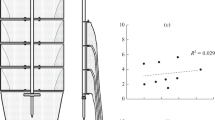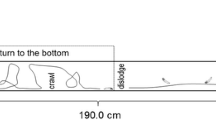Abstract
The hypothesis that Baëtis nymphs in the drift would show the phenomenon of size grading in a weakening water current if they behaved as passive sediment particles was tested. Laboratory studies with dead animals confirmed that larger animals sank faster than smaller ones. Similar tests with live animals in daylight gave four behavioural reactions to sinking, three of which would result in eventual leaving of the drift and one, commonest in the smaller instars, which would result in maintenance in the water-column. In the field, three treatments of nymphs were sampled by a series of nets down the length of a pool (‘depositing habitat’) and their changes in average size found. The baseline treatment was of dead animals, which gave the decline in size down the pool of passively drifting particles. The natural, night drift in the pool, and live animals introduced in daylight, were compared to this. The former showed no decline in size, indicating active drift, while the latter, with a steeper decline in size than the dead animals, indicated active leaving of the drift.
Similar content being viewed by others
References
Allan, J. D., 1978. The size composition of invertebrate drift in a Rocky Mountain stream. Oikos 43: 68–76.
Anderson, N. H., 1966. Depressant effect of moonlight on activity of aquatic insects. Nature (London) 209: 319–320.
Bailey, R. G., 1966. Observations on the nature and importance of organic drift in a Devon river. Hydrobiologia 27: 353–367.
Dorier, A. & F. Vaillant, 1954. Observations et experiences relatives a la resistance au courant de divers invertebres aquatiques. Trav. Lab. Hydrobiol. Piscic. Univ. Grenoble 45/46:9–31.
Elliot, J. M., 1967a. Invertebrate drift in a Dartmoor stream. Arch. Hydrobiol. 63: 202–237.
Elliot, J. M., 1967b. The life histories and drifting of the Plecoptera and Ephemeroptera in a Dartmoor stream. J. anim. Ecol. 36: 343–362.
Elliot, J. M., 1971. The distances travelled by drifting invertebrates in a Lake District stream. Oecologia 6: 350–379.
Hughes, D. A., 1966. On the dorsal light response in a mayfly nymph. Anim. Behav. 14: 13–16.
Hynes, H. B. N., 1970. The Ecology of Running Waters. Liverpool University Press, Liverpool, 555 pp.
Müller, K., 1974. Stream drift as a chronobiological phenomenon in running water ecosystems. Ann. Rev. Ecol. Syst. 5: 309–323.
Neveu, A., 1980. La derive des invertebres aquatiques et terrestres dans un petit fleuve cotier de l'ouest des Pyrenees, la Nivelle. Acta oecol./Oecol. Applic. 1: 317–339.
O'Hop, J. & B. Wallace, 1983. Invertebrate drift, discharge, and sediment relations in a southern Appalachian headwater stream. Hydrobiologia 98: 71–84.
Ulfstrand, S., 1968. Benthic animal communities in Lapland streams. Oikos Suppl. 10: 1–120.
Vinikour, W. S., 1981. Aquatic insect drift through a final-cut strip mine, with emphasis on drift distances. Hydrobiologia 77:225–232.
Walton, O. E., 1980. Active entry of stream benthic macroinvertebrates into the water-column. Hydrobiologia 74: 129–139.
Waters, T. F., 1965. Interpretation of invertebrate drift in streams. Ecology 46: 327–334.
Waters, T. F., 1972. The drift of stream insects. Ann. Rev. Ent. 17:253–272.
Author information
Authors and Affiliations
Rights and permissions
About this article
Cite this article
Campbell, R.N.B. Comparison of the drift of live and dead Baëtis nymphs in a weakening water current. Hydrobiologia 126, 229–236 (1985). https://doi.org/10.1007/BF00007500
Received:
Accepted:
Issue Date:
DOI: https://doi.org/10.1007/BF00007500




